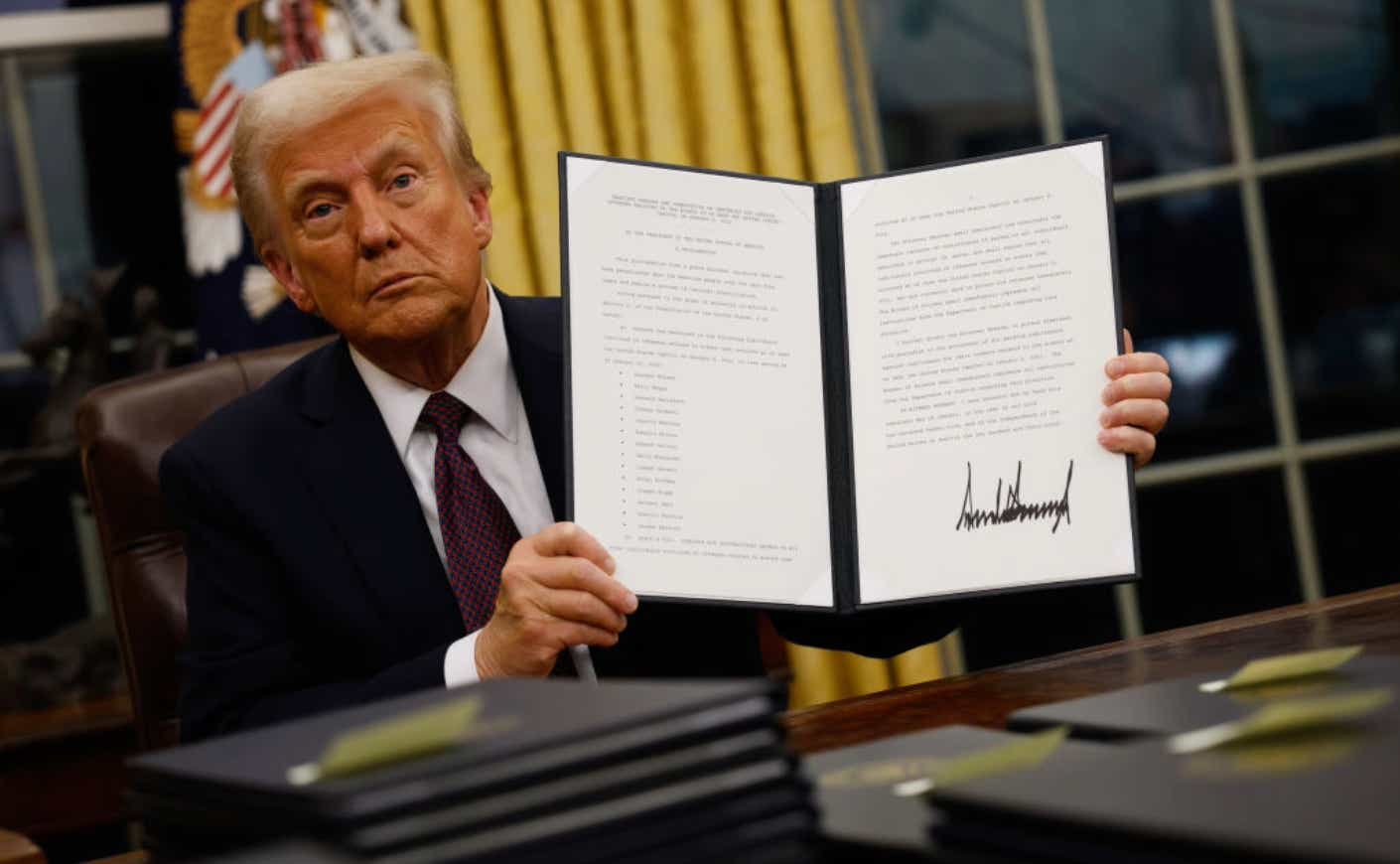Less than a month into President Donald Trump’s second term, we’ve very quickly gotten accustomed to hearing a lot of one particular phrase: executive orders.
To put it simply, executive orders (EOs) are directives from the president to federal agencies, telling them what actions to take — or avoid. While they aren’t laws themselves, they carry a lot of weight because they’re based on the president’s power under the U.S. Constitution.
EOs have historically been used to shape U.S. policy, from the Emancipation Proclamation to funding the Manhattan Project. But what happens when these orders face legal challenges? Are presidents above the law, or do they need to abide by court rulings? Let’s break it down.
What are executive orders anyway?
Executive orders are instructions from the president telling federal agencies and employees what to do or not do. While the U.S. Constitution does not mention these orders explicitly, they are widely recognized as an inherent part of the president’s executive authority under Article II of the U.S. Constitution.
Executive orders aren’t the same as laws, which only Congress has the power to make. For an executive order to be valid, it must be based on the president’s authority under the Constitution or a law passed by Congress. “Outside the foreign affairs and military context, the executive’s power is limited in Article II to taking care that the laws are faithfully executed,” explains Paul Schiff Berman, a law professor at George Washington University. “An executive order that violates the Constitution or a congressional statute is unlawful.”
Even then, a president’s power isn’t absolute. Federal courts can step in to review whether an executive order is legal or if the president is overstepping their authority. Simply put, no president is supposed to be able to issue an order that violates the Constitution, breaks federal laws, or infringes on Americans’ basic rights. (It’s worth noting, however, that what a president is “allowed” to do has now become murkier than ever, due to the Supreme Court’s ruling that presents are immune from being prosecuted for “official acts” — a move that many have described as “placing the president above the law.”)
Despite these apparent limitations, however, EOs are a powerful tool for presidents to enforce laws and influence policy within the executive branch. They have played pivotal roles in American history, from Abraham Lincoln’s Emancipation Proclamation during the Civil War to the authorization of funding for the Manhattan Project, which led to the development of the first atomic bombs during World War II.
While executive orders continue to spark debate, they are a longstanding tradition. Every president since George Washington in 1789 has issued them — except for William Henry Harrison, who died just one month into his term.
Trump is no exception. He set a record on his first day in office by signing more than 20 executive orders, the most ever issued on Inauguration Day. As of now, he has signed 54 of them, maintaining the pace of his first term, when he issued 220 between 2017 and 2021, according to Ballotpedia. If historical trends hold, he may surpass that total this time around. Two-term presidents typically issue an average of 328 executive orders, while single-term presidents average 216.
New presidents often amend, replace, or rescind executive orders from their predecessors. Trump has already rescinded at least 78 of Biden’s executive actions, covering a range of issues, including climate change policies, immigration reforms, and diversity, equity, and inclusion (DEI) measures.
What are some of Trump’s notable executive orders?
Trump’s latest orders cover a broad range of topics, including demographic diversity, civil rights, and federal spending. These are some of his more noteworthy of the bunch and a look at their implications.
Ending birthright citizenship
Trump’s push to end birthright citizenship followed his campaign promise to crack down on immigration. His EO told federal agencies to stop recognizing U.S. citizenship for children born on American soil unless at least one parent was a citizen or legal permanent resident — except for those on student, work, or other temporary visas.
But according to Georgetown law professor Eloise Pasachoff, that’s a direct violation of the 14th Amendment, which guarantees that all Americans born or naturalized in the United States are citizens, regardless of whether or not their parents are immigrants. “You can’t just write an executive order and decide the Constitution doesn’t apply anymore,” she says. “That’s not how the law works.”
Federal judges seem to agree. Three have already ruled against the order, with one blocking it from taking effect entirely.
The creation of the Department of Government Efficiency (DOGE)
The president rebranded the United States Digital Service as the Department of Government Efficiency, or DOGE, and appointed tech billionaire Elon Musk to lead it. Musk pledged that the new agency would target government waste, potentially cutting programs or even dismantling entire departments, like USAID.
As scrutiny over DOGE grows, House lawmakers have launched a subcommittee, led by Representative Marjorie Taylor Greene, to examine its activities. While Democrats have raised concerns about its legality and oversight, Republicans argue that the initiative is a necessary step toward cutting government inefficiency.
But legal experts question whether DOGE is even legitimate.
“The president doesn’t have the power to unilaterally create a new administrative department,” Berman says. “That’s up to Congress — they have to establish and fund it.”
Elimination of DEI Programs
Right after taking office, Trump signed three executive orders aimed at rolling back diversity, equity, inclusion, and accessibility (DEIA) initiatives. The first order targets DEIA programs in the federal government, including in federal contracting and spending. It says federal hiring, promotions, and performance reviews should focus only on individual merit, skills, and performance, leaving DEIA out of the picture.
The second order takes it a step further by banning federal departments from giving contracts to private organizations that enforce DEIA policies. It also revokes parts of the Equal Employment Opportunity (EEO) order from 1965, along with other related rules around federal contracts.
The third order seeks to eliminate DEI programs across the U.S. government, affecting not just federal agencies but also contractors who receive federal funds for diversity training. But Pasachoff points out that Trump doesn’t actually have the power to control federal funding. “The Constitution doesn’t give the president control over how we spend money or the conditions attached to federal spending,” she explains. “So if he wants to impose conditions, he needs to find a law that backs it up — and he hasn’t done that.”
Critics say these actions undermine long-standing efforts to ensure fair treatment, especially within the military. On the flip side, supporters argue that this is about cutting unnecessary red tape and streamlining government operations.
Why are Trump’s executive orders facing pushback?
Trump’s recent executive orders have faced resistance from the judiciary, leading to a big question: What happens if he just ignores the courts? (This wouldn’t be the first time: In 1832, the Supreme Court ruled that the Cherokee Nation was independent and didn’t have to follow Georgia’s laws, but President Andrew Jackson ignored the ruling and forcibly removed the Cherokee in the Trail of Tears.)
What’s concerning some experts is how Trump’s allies have suggested he’s above the law. Vice President J.D. Vance, for instance, argued on X that judges can’t challenge the president’s “legitimate power,” and Trump has openly criticized the courts, calling a judge’s order against Musk’s DOGE team “a disgrace” (though he also pledged to “abide by the courts”).
But the judges aren’t backing down, and they may impose penalties like fines, sanctions, or even jail time. While Kristin Hickman, a law professor at the University of Minnesota, told NPR that she doesn’t think jail time is likely, the legal battle could escalate.
This week, for the first time, a judge accused Trump of ignoring an order to release billions in federal grants, potentially setting the stage for a Supreme Court showdown.
“If the Supreme Court issues a strong rebuke, will Trump continue defying the courts? Time will tell,” says Berman. “But we’re already at a constitutional crisis.”
However, not everyone agrees we’re facing a crisis just yet. Trump is still dealing with legal challenges in lower courts, and so far, he hasn’t ignored any Supreme Court orders.
“We’re not there yet,” Hickman said in an NPR interview. “It’s not healthy for our body politic to overreact and use hyperbole.”









